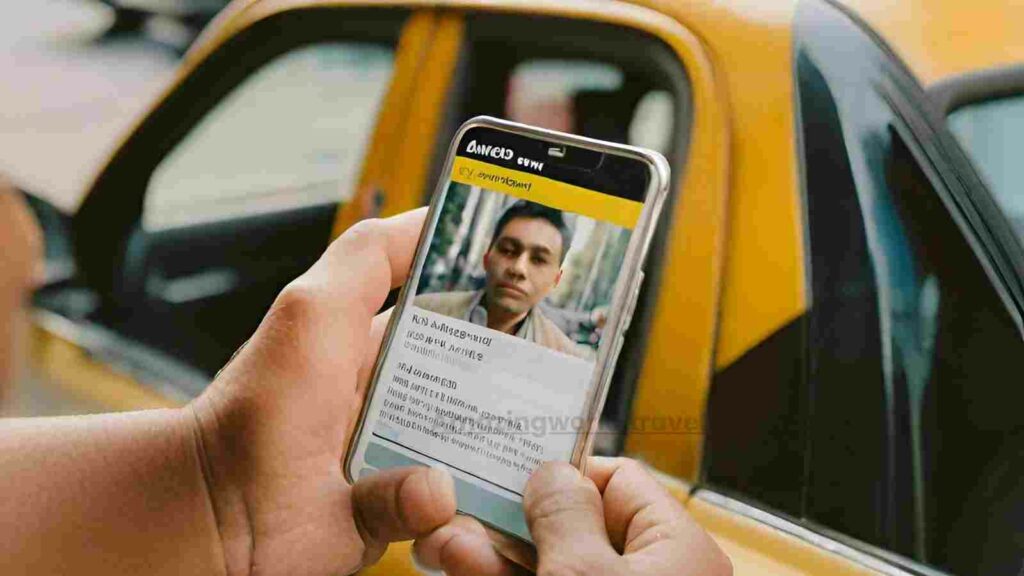10 Best Essential Taxi Safety Tips for Solo Travelers | Male and Female

Are you a solo traveler, male or female, embarking on an adventure to new and exciting destinations? Taxi rides can be a convenient and essential part of your journey. However, ensuring your safety during these rides is of paramount importance. In this guide, we will delve into essential taxi safety tips designed to keep you secure during your travels.
Whether you’re exploring bustling cityscapes or tranquil countryside, these tips, including researching local customs and reputable taxi services, checking driver identification, and staying vigilant during the ride, will empower you to navigate taxi journeys with confidence.
Join us as we explore these practical measures to make your solo travel experiences safer and more enjoyable.
Looking for the best Car Rental service for your next travel Jouney? Therefore, we recommend you book your car rental from DiscoverCars.com – Official Website
1. Research and Pre-Planning

Before embarking on your solo travel adventure, it’s crucial to engage in thorough research and pre-planning regarding taxi services at your destination. This step lays the foundation for a safe and hassle-free taxi experience. Here’s why it’s so essential:
Understanding Local Customs:
Different regions and cities around the world have their unique taxi customs and transportation systems. To navigate these effectively, research is your ally:
- Official Taxi Stands: Some places, particularly major airports and train stations, have official taxi stands. These are typically safe and well-regulated options for travelers. Researching whether your destination has these stands and their locations can help you easily find a taxi upon arrival.
- App-Based Ridesharing Services: In many modern cities, app-based ridesharing services like Uber, Lyft, or local equivalents have gained prominence. Knowing which services operate in your destination can be invaluable, as they often provide convenience and safety features like tracking your ride in real time.
- Local Taxi Services: In some areas, traditional taxi services may be the primary mode of transportation. Researching these local taxi companies, their contact information and service hours can prepare you for hailing a taxi when needed.
Pricing Knowledge:
Understanding taxi fares and common pricing practices at your destination can save you from overpaying or getting taken advantage of:
- Fare Structures: Different places have varying fare structures. Some may charge a flat rate for rides within a certain area, while others use a meter to calculate fares based on distance and time. Familiarizing yourself with these structures can help you gauge the approximate cost of your ride.
- Common Scams: Unfortunately, in some places, tourists can be targeted with overpriced or rigged meters. Researching common scams and pitfalls related to taxi fares can help you recognize when you’re being charged unfairly.
By conducting thorough research and pre-planning, you equip yourself with the knowledge and tools needed to navigate the local taxi landscape confidently. This not only enhances your safety as a solo traveler but also contributes to a smoother and more enjoyable travel experience. Remember, knowledge is your best defense when it comes to taxi safety.
2. Choosing Reputable Taxi Services

Your safety when using taxis as a solo traveler hinge on selecting a reputable taxi service. Here are key considerations to ensure you make a safe choice:
Licensed and Registered Taxis:
- Background Checks: Opt for taxis that are properly licensed and registered by local authorities. These taxis are more likely to have drivers who have undergone background checks, ensuring they do not have a criminal record or history of unsafe driving.
- Vehicle Safety Standards: Licensed taxis are generally required to meet specific safety standards. This includes regular maintenance checks to ensure the vehicle is in good working condition. Choosing such taxis reduces the risk of breakdowns or accidents due to poorly maintained vehicles.
- Insurance Coverage: Licensed taxis often come with insurance coverage that can protect you in the event of an accident. Unlicensed or informal taxis may not have insurance, leaving you vulnerable to financial liability in case of an accident.
Online Reviews:
- Reputation Matters: Before selecting a taxi service, check online reviews and ratings. Positive reviews and high ratings are indicative of a reliable and reputable service. Look for feedback from other solo travelers who can provide insights into their experiences.
- Consistency: Consistency in positive reviews is a good sign. If a taxi service consistently receives praise for safety, reliability, and professionalism, it’s likely a good choice.
- Negative Feedback: Pay attention to any negative feedback in reviews. While some negative comments may be isolated incidents, patterns of negative feedback regarding safety concerns or unprofessional behavior should be a red flag.
- Word of Mouth: Additionally, ask fellow travelers or locals for recommendations. Word-of-mouth recommendations from trusted sources can be a valuable resource in choosing a reputable taxi service.
By opting for licensed and registered taxis and conducting thorough research through online reviews and recommendations, you significantly enhance your safety as a solo traveler. A reputable taxi service is more likely to prioritize passenger safety and provide a reliable and secure transportation option for your travels.
3. Check Identification
Ensuring your safety during a taxi ride as a solo traveler involves taking a moment to verify the driver’s identification. Here’s why and how you should do it:
Driver’s Photo:
- Matching Photo: When you first enter the taxi, look at the driver’s photo. Most reputable taxi services, especially app-based rideshares, provide a photo of the assigned driver in the app or on their website.
- Verify Identity: Ensure that the driver’s appearance matches the photo provided by the taxi service or app. This visual confirmation helps confirm that you’re getting into the correct taxi with the authorized driver.
License and Identification:
- Request Driver’s License: If the driver’s photo is not prominently displayed or if you have any doubts, politely ask to see the driver’s license and identification. This is a reasonable request for your own safety.
- Verify Details: Examine the driver’s license to verify that it matches the name and photo provided by the taxi service or app. Ensure that the license looks legitimate and not tampered with.
- Note Vehicle Details: While checking the driver’s identification, also take a moment to confirm that the vehicle matches the one specified by the taxi service or app. Check the license plate number to ensure it matches the information provided.
By diligently checking the driver’s identification, you reduce the risk of getting into an unauthorized or unregistered vehicle, which can be a safety concern for solo travelers. This simple yet effective precaution adds an extra layer of security, ensuring that you are in the right taxi with a legitimate driver who has been vetted by the service.
Share Your Trip Details
Sharing your trip details with a trusted friend or family member is a vital safety practice when taking a taxi as a solo traveler. Here’s why and how to do it:
Share Your Location:
- Trusted App: Utilize a trusted ride-sharing or GPS tracking app to share your ride’s real-time location with a friend or family member. Many ride-sharing apps offer built-in features for sharing trip details.
- Real-Time Updates: By sharing your location, your trusted contact can follow your journey in real-time on a map, ensuring that you reach your destination as planned.
- Peace of Mind: This practice provides peace of mind for both you and your loved ones. They can monitor your progress and be alerted if your trip deviates from the expected route or duration.
Emergency Contacts:
- Driver’s Information: Ensure that someone you trust knows your driver’s name and license plate number. This information is crucial in case of an emergency or if you need assistance during the ride.
- Check-In System: Establish a check-in system with your trusted contact. For example, you can agree to send a message or make a quick call once you’ve safely reached your destination.
- Emergency Response: In the rare event of an emergency or if you feel unsafe during the ride, your trusted contact will have the necessary information to assist you or contact authorities if needed.
By sharing your trip details, you create a safety net for yourself while traveling alone in a taxi. It ensures that someone knows where you are, who your driver is, and can take action if there are any concerns or emergencies. This simple precaution enhances your safety and offers peace of mind to both you and your loved ones.
4. Stay Aware of Your Surroundings
Remaining vigilant and aware of your surroundings is essential for your safety during a taxi ride as a solo traveler. Here’s why and how to do it:
Route Awareness:
- Monitor the Route: Pay attention to the route your driver is taking. Familiarize yourself with the general directions and landmarks between your pickup location and destination. If the driver takes an unexpected or unusual route, it’s essential to stay alert.
- Ask for Clarification: If you notice the driver deviating significantly from the expected route, don’t hesitate to politely ask for an explanation. Expressing your awareness can deter any potential issues and ensure you are on the correct path.
In-Car Cameras:
- Recognize Camera Presence: Many taxis, especially in modern cities, are equipped with in-car cameras for safety and security purposes. These cameras are typically visible to passengers.
- Deterrence Effect: The knowledge that you are being recorded can deter any potential misconduct or inappropriate behavior from the driver. It serves as an additional layer of protection for passengers.
- Document Incidents: In the rare event that you encounter any problems during the ride, having in-car cameras can be valuable. They can document any incidents or disputes, providing evidence if needed later.
Staying aware of your surroundings and being attentive to the route and in-car cameras enhances your safety as a solo traveler in a taxi. It empowers you to take action if something doesn’t seem right and provides a sense of security knowing that your journey is being monitored. Remember that your safety is a priority, and it’s perfectly acceptable to voice any concerns or questions during the ride.
5. Avoid Sharing Personal Information

Engaging in conversation with your taxi driver can be a pleasant part of your journey. However, it’s essential to exercise caution and avoid sharing personal information, especially as a solo traveler. Here’s why and how to protect your privacy and safety:
Privacy:
- Confidentiality: Your personal information, such as your exact address, home, or where you’re staying, should remain confidential during the ride. Share only what is necessary for the purpose of the trip.
- Identity Protection: By keeping personal details private, you safeguard your identity and prevent potential misuse of your information. Protecting your privacy is a fundamental aspect of personal safety.
Safety:
- Risk Mitigation: Sharing too much personal information with a stranger, even a taxi driver, can put you at risk. Criminals can exploit this information to target you or your property, especially if they have nefarious intentions.
- Unwanted Contact: Revealing personal details may result in unwanted contact or harassment after the ride is over. It’s crucial to maintain boundaries and prioritize your safety.
- Redirect the Conversation: If the driver becomes overly inquisitive or insistent about personal information, politely redirect the conversation to neutral topics like local attractions or the weather. You have every right to maintain your privacy.
Remember that while it’s okay to engage in small talk and be friendly, your safety should always come first. By keeping personal information confidential and being cautious about what you share, you reduce the risk of potential harm or unwanted attention during your taxi ride as a solo traveler.
6. Seat Placement
Choosing where to sit in the taxi is an important safety consideration for solo travelers. Here’s why seat placement matters and how to make a safe choice:
Behind the Driver:
- Clear View: Opting to sit behind the driver is generally considered safer. This position allows you to have a clear view of both the driver and the road ahead.
- Visibility: Being in this position enables you to monitor the driver’s actions and behavior. It can provide an added sense of security, as you can observe their actions and reactions during the ride.
- Emergency Exit: Sitting behind the driver also positions you closer to the front door, which can be an advantage in case you need to exit the taxi quickly in an emergency.
Avoid the Front Seat
- Traveling Alone: If you are traveling alone, it’s advisable to avoid sitting in the front seat, especially at night. This is because the front seat may offer less physical separation from the driver, potentially making you feel more vulnerable.
- Safety Precaution: While many taxi drivers are courteous and professional, it’s a safety precaution to choose the back seat when you’re on your own. This helps maintain a respectful distance between you and the driver.
- Personal Space: Sitting in the back seat also provides you with more personal space and a sense of privacy, which can be comforting, especially during long rides.
By opting to sit behind the driver and avoiding the front seat when traveling alone, you can enhance your safety and comfort during your taxi journey. It allows you to maintain better visibility and a respectful distance from the driver, contributing to a more secure and worry-free experience.
7. Keep Valuables Secure
Ensuring the safety of your belongings during a taxi ride is crucial for solo travelers. Here are practical tips to keep your valuables secure:
Use Seat Belts:
- Safety First: Always prioritize your safety by wearing your seat belt as soon as you enter the taxi. This not only protects you in case of an accident but also helps keep you securely in your seat.
- Secure Your Bags: Make sure your bags and belongings are securely placed on the seat or on the floor between your legs. Unsecured items can become dangerous projectiles during sudden stops or accidents.
- Backpacks and Purses: If you have a backpack or purse, place it on the seat beside you rather than on your lap. This ensures it stays in place and doesn’t obstruct your movement or the driver’s view.
Valuables Out of Sight:
- Conceal Valuables: Keep valuable items like smartphones, wallets, jewelry, and electronics out of sight from the driver and other passengers. Use bags or pockets that can be closed securely.
- Avoid Flashy Displays: Refrain from displaying expensive items while in the taxi. Using your phone or showing off valuable jewelry can attract unwanted attention.
- Lock Your Phone: If you need to use your phone for navigation or communication during the ride, lock it securely when not in use. This adds an extra layer of protection in case it’s accidentally left behind.
- Keep Cash Separated: If you must carry cash, divide it into separate pockets or compartments. This way, you won’t reveal the full extent of your funds if you need to make a payment.
By following these tips, you reduce the risk of theft and ensure the safety of your belongings during your taxi ride. Taking these precautions is especially important for solo travelers, as you may not have someone else to watch over your possessions. Prioritizing the security of your valuables contributes to a more stress-free and enjoyable journey.
8. Trust Your Instincts
Trusting your instincts is a critical aspect of staying safe while traveling solo in a taxi. Here’s why and how to do it:
Safety First:
- Listen to Your Gut: Your intuition can be a powerful tool for assessing safety. If something about the taxi ride feels off, pay attention to your instincts. If your gut tells you that something isn’t right, take it seriously.
- Speak Up: If you feel uncomfortable or unsafe during the ride, don’t hesitate to take action. Politely ask the driver to pull over in a well-lit, public area, and express your concerns. Your safety is paramount.
- Have a Plan: Before starting your journey, consider having a plan in place for what to do if you encounter a situation that makes you uneasy. This might include knowing the nearest public places or police stations where you can seek help.
Emergency Options:
- Know Local Emergency Numbers: Be aware of how to contact local emergency services at your destination. In different countries, emergency numbers may vary. Save these numbers in your phone or have them readily accessible.
- Pre-program Contacts: Ensure that you have important contacts, such as local authorities or trusted friends, pre-programmed in your phone for quick access in case of an emergency.
- Share Your Location: If you have shared your trip details with a trusted contact (as mentioned in a previous tip), they can also be a valuable resource if you need assistance during the ride.
- Have a Charged Phone: Always ensure your phone is charged and has adequate battery life. A fully charged phone is your lifeline in case of emergencies.
Trusting your instincts and taking action when something feels off can help you avoid potentially dangerous situations during a taxi ride. Your safety is paramount, and it’s essential to prioritize it by being prepared, assertive, and proactive in seeking help or assistance when needed.
9. Payment and Tipping

Handling payment correctly is not only about convenience but also about ensuring a smooth and safe taxi experience. Here’s why and how to manage payment and tipping:
Payment Methods:
- Cashless Payment: Whenever possible, opt for cashless payment methods like credit cards or mobile payment apps (e.g., Apple Pay, Google Pay). Using cashless methods reduces the need to handle physical money, which can be safer and more hygienic.
- Convenience: Cashless payments are often more convenient, as they eliminate the need for exact change or dealing with unfamiliar currencies. They also provide a digital record of the transaction, which can be useful for tracking expenses.
- Safety: Carrying less cash reduces the risk of theft or loss during your journey. It’s also a safer option, especially when traveling in unfamiliar places.
Tipping:
- Know the Customs: Be aware of tipping customs in the area you’re visiting. In some places, tipping is not expected or necessary, while in others, it’s customary and appreciated.
- Research: Prior to your trip, research the tipping norms for taxis at your destination. Online travel forums, travel guides, or local advice can provide insight into what is considered an appropriate tip.
- Round Up: If you’re unsure about the tipping amount, consider rounding up the fare to the nearest convenient amount. For example, if the fare is $18.50, rounding up to $20 is a simple way to leave a tip.
- Exceptional Service: If your driver has provided exceptional service or has gone out of their way to assist you, consider leaving a more generous tip as a token of appreciation.
Managing payment and tipping properly not only ensures a smooth transaction but also contributes to a positive interaction with your taxi driver. By using cashless methods when feasible and adhering to local tipping customs, you enhance your overall taxi experience while maintaining your financial safety and security during your solo travels.
10. Post-Ride Safety

Your safety-conscious approach doesn’t end when the taxi ride is over. Taking some post-ride precautions is equally important to ensure a seamless conclusion to your journey:
Review the Trip:
- Check for Belongings: Before exiting the taxi, take a moment to review the trip and ensure you haven’t left any personal belongings behind. It’s easy to forget items like phones, bags, or jackets in the rush to exit.
- Double-check the Seat: Specifically, double-check the seat and the area around you. Items can easily get wedged between seats or fall to the floor.
- Valuables Secure: Make sure your valuables are securely stored and haven’t shifted during the ride. Ensure that you have everything you came with.
Driver Rating:
- Consider Rating: If you used a ridesharing app for your taxi service, consider rating the driver based on your experience. Your feedback can be valuable for both the driver and future passengers.
- Provide Constructive Feedback: If you had a particularly good or bad experience, consider leaving comments in addition to the rating. Positive feedback can acknowledge a job well done, while constructive criticism can help the driver improve.
- Safety Matters: Mention any safety-related observations in your feedback. If you felt unsafe or encountered any issues during the ride, sharing this information can help improve safety standards.
By taking these post-ride safety measures, you ensure that your taxi journey reaches a satisfactory conclusion. It’s a responsible practice to ensure you haven’t left anything behind and to provide feedback on your experience, helping both drivers and future passengers. Your commitment to safety extends beyond the ride itself and contributes to a safer and more enjoyable overall travel experience.
Conclusion
Your safety as a solo traveler in taxis is paramount, and these essential safety tips are designed to enhance your security and peace of mind throughout your journey. First and foremost, thorough research and pre-planning before your trip lay the foundation for a smooth taxi experience, helping you understand local customs and pricing practices. Choosing reputable taxi services, including licensed and registered providers with positive online reviews, ensures you’re in safe hands.
Checking the driver’s identification, both their photo and identification documents, is a simple yet crucial step to confirm your safety. Sharing your trip details with a trusted contact not only adds an extra layer of security but also provides peace of mind to both you and your loved ones.
Remaining vigilant during the ride by staying aware of the route and acknowledging the presence of in-car cameras can help deter potential issues. Avoiding sharing personal information and being cautious about seat placement, especially when traveling alone, contribute to your overall safety.
How much did you like Our Detailed 10 Best Essential Taxi Safety Tips for Solo Travelers | Male and Female? Review Also, please share these Blogs with your friends on social media.
Recommended

Meet David Hoper, a passionate travel Blog writer with 7+ years of experience in travel content. Through his exemplary storytelling and engaging narratives, he shares his experiences and brings destinations to life. With a keen eye for detail and a love for exploration, he has cultivated a diverse portfolio of travel blogs that inspire and inform readers worldwide.







